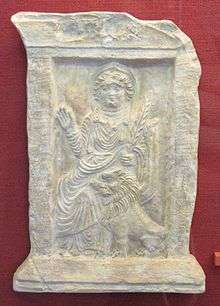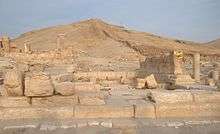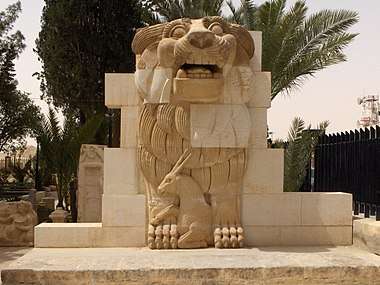Al-Lat
| Al-Lāt | |
|---|---|
 | |
| Major cult center | Palmyra, Ta'if |
| Symbol | lion, gazelle, crescent, cubic rock |
| Region | Arabia |
| Personal information | |
| Consort |
Lion of Al-lāt (Palmyrene tradition)[1] Dushara (Nabataean tradition) |
| Children | Dushara (Nabataean tradition) |
| Parents | Allah[2][3][4][5] |
| Siblings | Al-‘Uzzá, Manāt |
| Equivalents | |
| Greek equivalent | Athena |
| Roman equivalent | Minerva |
| Carthaginian equivalent | Allatu |
Allat, also spelled Allatu, Alilat, Allāt, and al-Lāt (Arabic: اللات, pronounced [al(i)ˈlaːt(u)]) is a name and title used to refer to multiple goddesses worshipped in the ancient Near East, including the Semitic goddesses Asherah and Athirat. More importantly, it refers to the pre-Islamic Arabian goddess worshipped alongside Manāt and al-‘Uzzá throughout the entire peninsula, including Mecca.
According to records from the Islamic period, the tribe of Banu Thaqif in Ta'if especially holds reverence to her. Under Greco-Roman influence, her iconography began to show the attributes of Athena, the Greek goddess of war, as well as her Roman equivalent Minerva. In Islamic tradition, her worship ended when her shrine in Ta'if was demolished on the orders of Muhammad.
Etymology and name
There are two possible etymologies of the name al-Lat.[6] The etymology best reflecting the Arab lexicographical tradition derives the name from the verb latta (to mix or knead barley-meal). It has also been associated with the "idol of jealousy" erected in the temple of Jerusalem according to the Book of Ezekiel, which was offered an oblation of barley-meal by the husband who suspected his wife of infidelity. It can be inferred from al-Kalbi's Book of Idols that a similar ritual was practiced in the vicinity of the idol of al-Lat.[6] The second etymology, which is more in line with Semitic traditions in general, takes al-Lat to be the feminine form of Allah.[6]
As a title
The word al-Lat was used as a name and title for multiple pre-Islamic goddesses of Arabia and was used for either a wife of Allah or a daughter depending on the region.[7] It has been hypothesized that Allat is the consort of Allah based on the fact that it is typical of deities in that area of the world to have consorts.[8] It was used as a title for the goddesses Asherah and Athirat.[9] The word is akin to Elat, which was the name of the wife of the Semitic deity El.[10]
Especially in older sources, Allat is an alternative name of the Mesopotamian goddess of the underworld,[11][12] now usually known as Ereshkigal. She was reportedly also venerated in Carthage under the name Allatu.[13]
Attestations
Pre-Islamic era
Al-Lat was worshipped throughout Arabia, and her cult reached as far as Syria. From Safaitic and Hismaic inscriptions, it is probable that she was worshiped as Lat (lt).[14]
The Greek historian Herodotus, writing in the 5th century BC, considered her the equivalent of Aphrodite:
The Assyrians call Aphrodite Mylitta, the Arabians Alilat [Greek spelling: Ἀλιλάτ], and the Persians Mithra.[15]
Herodotus acknowledged Alilat to be the equivalent of Aphrodite Ourania.[16] According to Herodotus, the ancient Arabians believed in only two gods:
They believe in no other gods except Dionysus and the Heavenly Aphrodite; and they say that they wear their hair as Dionysus does his, cutting it round the head and shaving the temples. They call Dionysus, Orotalt; and Aphrodite, Alilat.[17]
Al-Lat's worship in South Arabia was not popular.[18] She was not the object of an organized cult, with two amulets (inscribed "Lat" on one, "Latan" on the other) being the only indication that this goddess received worship.[18]
Al-Lat was worshipped the most in northern Arabia. The Qedarites, a northern Arabian tribal confederation, seemed to also worship al-Lat, as evidenced by a silver bowl dedicated by a Qedarite king, with the goddess' name inscribed on it.[19]
The Nabataeans and the people of Hatra also worshipped al-Lat, equating her with the Greek Athena and Tyche and the Roman Minerva. She is frequently called "the Great Goddess" in Greek in multilingual inscriptions.[20] The Nabataeans regarded al-Lat as the mother of the deities, and her family relations vary; sometimes she is regarded as the consort of Dushara, other times she is regarded as the mother of Dushara.[14] Nabataean inscriptions state her as well as Al-'Uzza as the "brides of Dushara".[21] According to Wellhausen, the Nabataeans believed al-Lat was the mother of Hubal (and hence the mother-in-law of Manāt).[22]

Al-Lat was also venerated in Palmyra, which housed an Arab population, and there her temple had no signs of blood rituals. By the second-century AD, she began to be portrayed in the style of Athena, and was referred to as "Athena-Allāt", but this assimilation does not extend beyond its iconography.[23] A famous statue that once adorned her temple there was the Lion of Al-lāt, once damaged by the Islamic State of Iraq and the Levant (ISIL), but has been since restored.
Islamic era

In records during the Islamic period discussing pre-Islamic Arabia, al-Lat is attested as the chief-goddess of the Banu Thaqif tribe. She was said to be venerated in Taif, where she was called ar-Rabbah (The Lady).[24] She reportedly had a shrine there which was decorated with ornaments and treasure of gold and onyx.[25] There, the goddess was venerated in the form of a cubic rock.[26] The area around the shrine was sacred; no trees could be felled, no animal hunted and no human blood can be shed.[27][28]
Al-Lat is also mentioned in pre-Islamic Arab poetry, which were belatedly put into writing. She was alluded by al-Mutalammis in his satire of Amr ibn-Hind:[29]
Thou hast banished me for fear of lampoon and satire.
No! By Allat and all the sacred baetyls (ansab)
thou shalt not escape.
A poem by the pre-Islamic monotheist Zayd ibn Amr mentions al-Lat, along with Al-Uzza and Hubal:[30]
Am I to worship one lord or a thousand?
If there are as many as you claim,
I renounce al-Lat and al-Uzza, both of them,
as any strong-minded person would.
I will not worship al-Uzza and her two daughters …
I will not worship Hubal, though he was our lord
in the days when I had little sense.
According to the Book of Idols by Hishām ibn al-Kalbi, the pre-Islamic Arabs believed Al-Lat resided in the Kaaba and also had an idol inside the sanctuary:
Her custody was in the hands of the Banū Attāb ibn Mālik of the Thaqīf, who had built an edifice over her. The Quraysh, as well as all the Arabs, venerated al-Lāt. They also used to name their children after her, calling them Zayd al-Lāt and Taym al-Lāt. [...] Al-Lāt continued to be venerated until the Thaqīf embraced Islam, when Muhammad dispatched al-Mughīrah ibn-Shu‘bah, who destroyed her and burnt her temple to the ground.[31][32][33]
In the Qur'an, she is mentioned along with al-‘Uzzá and Manāt in Sura 53:19–23, a verse that became the subject of the alleged Satanic Verses. The tribe of ʿād of Iram of the Pillars is also mentioned in Sura 89:5–8, and archaeological evidence from Iram shows copious inscriptions devoted to her for the protection of a tribe by that name.[34]
According to Islamic tradition, the shrine dedicated to al-Lat in Ta'if was demolished on the orders of Muhammad, during the Expedition of Abu Sufyan ibn Harb, in the same year as the Battle of Tabuk[25] (which occurred in October 630 AD).[35][36] The destruction of the idol was a demand by Muhammad before he would allow any reconciliation to take place with the tribes of Ta'if, who were under his siege.[37]
Mythological role
F. V. Winnet saw al-Lat as a lunar deity due to association of a crescent with her in 'Ayn esh-Shallāleh and a Lihyanite inscription mentioning the name of Wadd over the title of 'fkl lt. René Dussaud and Gonzague Ryckmans linked her with Venus while others have thought her to be a solar deity. John F. Healey considers al-Uzza actually might have been an epithet of al-Lat before becoming a separate deity in Meccan pantheon.[14] Redefining Dionysos considers she might have been a god of vegetation or a celestial deity of atmospheric phenomena and a sky deity.[38] She was also called as daughter of Allah along with the other two chief goddesses Al-'Uzza and Manat.[2][3][4][5]
Iconography

In Ta'if, Al-Lat's primary idol is a cubic stone,[26] which according to the Book of Idols, is associated with a Jew who prepares his barley porridge. Treasures that once adorned her shrine include gold and onyx.
Early Palmyrene depictions of Al-Lat share iconographical traits with Atargatis (when seated) and Astarte (when standing).[39] The Lion of Al-Lat that once adorned her temple depicts a lion and a gazelle, the lion representing her consort,[1] and the gazelle representing Al-Lat's tender and loving traits, as bloodshed was not permitted under Al-Lat's retaliation.[40]

Al-Lat was associated with the Greek goddess Athena (and by extension, the Roman Minerva) in Nabataea, Hatra and Palmyra. It seems that her identification with Athena was only a mere change in iconography, and Al-Lat's character noticeably softened the warlike Athena in places where she was equated with.[41] One Nabataean relief of Athena-Al-Lat depicts the goddess bearing both Athena and Al-Lat's attributes. The relief depicts the goddess in the style of Athena, but having a stylized square face (resembling Nabataean eye-idols) in place of the Gorgoneion.[41]
Al-Lat was closely related with Al-'Uzza, and in some regions of the Nabataean kingdom, both Al-Lat and Al-'Uzza were said to be the same goddess. John F. Healey believes that Al-Lat and Al-'Uzza originated as a single goddess, which parted ways in the pre-Islamic Meccan tradition.[14] Susan Krone suggests that both Allat and Al-'Uzza were uniquely fused in central Arabia.[42]
In popular culture
In Frank Herbert's Dune series, Al-Lat is the name given to the earth's sun.
Multiple allusions, references and parallels are in Salman Rushdie's The Satanic Verses.
See also
Bibliography
- Strong's Hebrew and Aramaic Dictionary of Bible Words
- Georgii Wilhelmi Freytagii : Lexicon Arabico-Latinum. Librairie du Liban, Beirut, 1975.
Notes
- 1 2 Butcher 2003, p. 309.
- 1 2 Berkey 2003, p. 42.
- 1 2 Robinson 2013, p. 75.
- 1 2 Peters 1994, p. 110.
- 1 2 Peterson 2007, p. 21.
- 1 2 3 T. Fahd (1986). "al-Lat". In P. Bearman, Th. Bianquis, C.E. Bosworth, E. van Donzel, W.P. Heinrichs. Encyclopaedia of Islam. 5 (2nd ed.). Brill. p. 692.
- ↑ Hughes, p. 25.
- ↑ Monaghan 2014, p. 30.
- ↑ Monaghan 2014, p. 31.
- ↑ Sykes & Turner 2014, p. 7, 8, 63.
- ↑ The Dawn of Civilisation, by: Gaston Maspero
- ↑ «A History Of Art In Chaldæa & Assyria» Georges Perrot, Professor in The Faculty of Letters, Paris; Member of The Institute, and Charles Chipiez. New York, 1884.
- ↑ Encyclopedia of Gods, Michael Jordan, Kyle Cathie Limited, 2002
- 1 2 3 4 Healey 2001, p. 114.
- ↑ Histories I:131
- ↑ Corrente 2013, p. 265.
- ↑ Histories III:8
- 1 2 McAuliffe 2005, p. 88.
- ↑ Hoyland 2002, p. 63.
- ↑ Healey 2001, p. 136.
- ↑ Corrente 2013, p. 263.
- ↑ Wellhausen, 1926, p. 717, quoted in translation by Hans Krause Archived 2005-02-16 at the Wayback Machine.
- ↑ Teixidor 1979, p. 62.
- ↑ Brockelmann 1960, p. 9.
- 1 2 Tabari 1990, p. 46.
- 1 2 al-Kalbi 1952, p. 14.
- ↑ Eckenstein 2018, p. 24.
- ↑ Majid 1991, p. 271.
- ↑ al-Kalbī 1952, p. 15.
- ↑ Ishaq 1955, p. 100.
- ↑ al-Kalbī 1952, p. 14–15.
- ↑ Oxfordislamicstudies.com
- ↑ Mify narodov mira 1984. Article: Allat
- ↑ Healey 2001, p. 111.
- ↑ Hawarey, Dr. Mosab (2010). The Journey of Prophecy; Days of Peace and War (Arabic). Islamic Book Trust. Archived from the original on 2012-03-22.
- ↑ Muir 1878, p. 207.
- ↑ Muir 1878, p. 205.
- ↑ Corrente 2013, p. 265-266.
- ↑ Teixidor 1979, p. 61.
- ↑ Baaren 1982, p. 70.
- 1 2 Taylor 2001, p. 130.
- ↑ Krone 1992, p. 96.
References
- Berkey, Jonathan Porter (2003), The Formation of Islam: Religion and Society in the Near East, 600-1800, Cambridge University Press, ISBN 978-0-521-58813-3
- Brockelmann, Carl (1960), History of the Islamic Peoples, translated by Perlmann, Moshe; Carmichael, Joel, Capricorn Books
- Butcher, Kevin (2003), Roman Syria and the Near East, Getty Publications, ISBN 0892367156
- Corrente, Paola (2013), Alberto Bernabé, Miguel Herrero de Jáuregui, Ana Isabel Jiménez San Cristóbal, Raquel Martín Hernández, ed., Redefining Dionysos, Walter de Gruyter, ISBN 3110301326
- Eckenstein, Lina (2018), A History of Sinai, Cambridge University Press, ISBN 1108082335
- Healey, John F. (2001), The Religion of the Nabataeans: A Conspectus., BRILL, ISBN 9004107541
- Hoyland, Robert G. (2002), Arabia and the Arabs: From the Bronze Age to the Coming of Islam, Routledge
- Hughes, Aaron W., The Idea of Idolatry and the Emergence of Islam: From Polemic to History, Columbia University Press
- Ishaq, Muhammad Ibn (1955), The Life of Muhammad: A Translation of Ishaq's Sirat Rasul Allah, with Introduction and Notes by A. Guillaume, Oxford University
- al-Kalbī, Ibn (1952), Book of Idols, translated by Faris, Nabih Amin, Princeton University Press, Library of Congress #52006741
- Krone, Susan (1992), Die altarabische Gottheit al-Lat Cited in Arabic Theology, Arabic Philosophy: From the Many to the One, Berlin: Speyer & Peters GmbH, ISBN 9783631450925
- Majid, Abdul (1991), Tafsir-ul-Qurʼan: Translation and Commentary of the Holy Qurʼan, Darul-Ishaat
- McAuliffe, Jane Dammen (2005), Encyclopaedia of the Qurʼān, Volume 5, Brill, ISBN 9004123563
- Monaghan, Patricia (2014), Encyclopedia of Goddesses and Heroines, New World Library, ISBN 978-1-608-68218-8
- Muir, William (1878), The life of Mahomet (Full free digitized version), Kessinger Publishing Co, p. 207
- Peters, Francis E. (1994), Muhammad and the Origins of Islam, SUNY Press, ISBN 978-0-7914-1875-8
- Peterson, Daniel C. (2007), Muhammad, Prophet of God, Wm. B. Eerdmans Publishing, ISBN 978-0-8028-0754-0
- Robinson, Neal (2013), Islam: A Concise Introduction, Routledge, ISBN 978-1-136-81773-1
- Sykes, Egerton; Turner, Patricia (2014), Encyclopedia of Ancient Deities, Routledge
- Tabari, Al (25 Sep 1990), The last years of the Prophet (translated by Isma'il Qurban Husayn), State University of New York Press, ISBN 978-0887066917
- Taylor, Jane (2001), Petra and the Lost Kingdom of the Nabataeans, I.B.Taurus, ISBN 1860645089
- Teixidor, Javier (1979), The Pantheon of Palmyra, Brill Archive, ISBN 9004059873
External links
| Wikimedia Commons has media related to Allat. |
- Allah, the unique name of God
- Herodotus 1:131 online
- Herodotus 3:8 online
- Sunni account from witness-pioneer.org